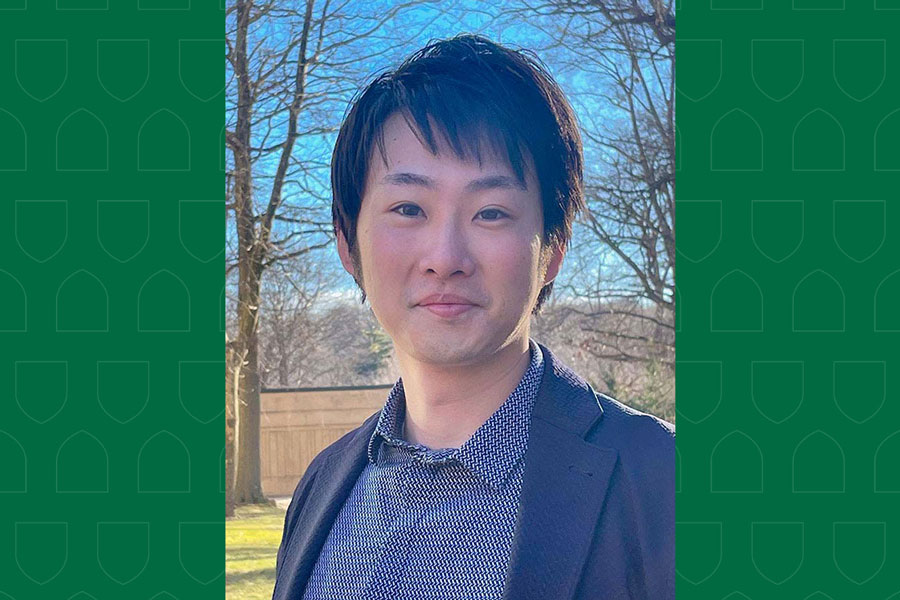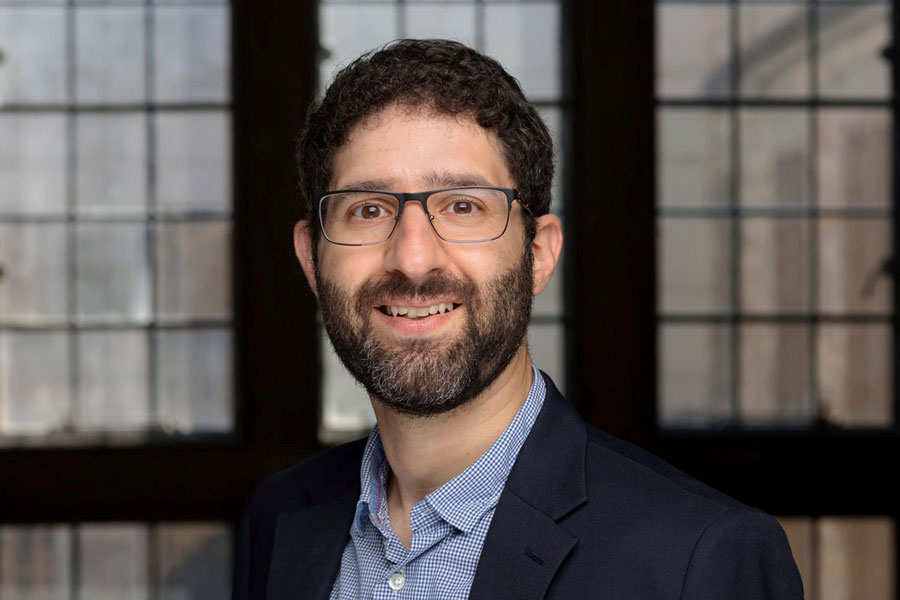
‘Unwillingness to accept any limitations as to what is possible’
Dr. Kazuki Ikeda, a former USask postdoctoral fellow who worked at quanTA, is breaking new ground in quantum science
By SHANNON BOKLASCHUKOne of the world’s rising stars in quantum science describes his time at the University of Saskatchewan (USask) “as the most important milestone” of his career.
Originally from Japan, Dr. Kazuki Ikeda (PhD) moved to Saskatchewan during the global COVID-19 pandemic to take on a postdoctoral fellowship at quanTA, the Centre for Quantum Topology and Its Applications, in USask’s College of Arts and Science. The centre is known for bringing together experts from mathematics, physics, chemistry, computing, and other disciplines to work on all aspects of quantum materials, quantum information and computing, and quantum technology development in general.
For Ikeda, who earned his PhD at the University of Osaka in Japan in 2020, joining quanTA was the perfect fit.
“quanTA has an excellent mixture of interdisciplinary people with a good number of undergrad and graduate students, postdocs, and faculty,” he said. “They are expanding the boundary of quantum science related to mathematics, physics, chemistry, and biology.”

Ikeda was a postdoctoral fellow at quanTA from November 2021 to August 2022 under the supervision of Dr. Steven Rayan (DPhil), quanTA’s director, a professor in USask’s Department of Mathematics and Statistics, and interim vice-dean research, scholarly and artistic work in the College of Arts and Science. Ikeda’s fellowship was funded by the Pacific Institute for the Mathematical Sciences (PIMS) and his appointment was associated with the Collaborative Research Group Award from PIMS that supported quanTA from 2020 to 2024.
While Ikeda arrived at USask from Japan facing lengthy delays and other challenges due to the pandemic, he thrived during his time in Saskatchewan, publishing influential papers and expanding his research across multiple directions of quantum physics, quantum computing, and quantum materials. He also began writing a book on quantum information theory, with applications to economics and finance, and worked on projects with various PhD students at USask.
Rayan described Ikeda’s work in quantum science “as closing the gap between current quantum computers and the claims that quantum computing will one day change our lives.”
“Rather than defer these promises to future hardware and innovations, Kazuki is exploring applications of today’s quantum computers to finance, economics, cryptocurrencies, and information privacy,” said Rayan. “People are paying attention because Kazuki is turning promises into realities.”
During Ikeda’s time at USask, both Ikeda and Rayan were interviewed by Scientific American. After his time at USask, Ikeda took on another fellowship at Stony Brook University before earning a tenure-track position in the Department of Physics at the University of Massachusetts Boston (UMass Boston) in 2024.
Rayan said Ikeda is “fearless in his work.”
“He takes risks by trying to shed new light on problems perceived to be incredibly difficult or by trying to demonstrate phenomena that are theoretically anticipated but which many experts would agree are very far away from being realized. For example, one of Kazuki’s recent papers is on ‘quantum energy teleportation’. This is a major breakthrough that builds on an earlier concept of ‘quantum information teleportation’, or just ‘quantum teleportation’, which is a cool way of saying that we can transfer quantum information from one place to another, say, from one particle to another or from a sender to a receiver,” Rayan said.
“This is now a well-known and achievable phenomenon, and it is at the heart of quantum communications and quantum-driven data security. However, the next frontier in technology lies in the quantum transfer of features beyond just information. Using real quantum computing hardware, Kazuki was able to demonstrate the teleportation of quantum energy from one quantum computer to another. He very creatively used quantum machines manufactured by IBM in these experiments. To me, this is a spectacular result that demonstrates Kazuki’s unwillingness to accept any limitations as to what is possible.”
Ikeda recently authored an invited review for the Canadian Journal of Physics, titled “Quantum Energy in Quantum Computers: Insights from Quantum Energy Teleportation.” The Green&White alumni news website asked him about his time at USask and what fascinates him about quantum innovation. In collaboration with the Alumni Office, USask’s College of Graduate and Postdoctoral Studies offers all USask postdoctoral scholars associate alumni status upon the completion of their appointment.

G&W: What was your first impression of USask?
Ikeda: I enjoyed the natural environment of USask. Every day, before and after work, I walked by the pond near the campus to try to see beavers—although I finally saw them only in the spring. It was my first time seeing a large frozen river. I learned to ice skate and skated every day, even in -40 C. In Canada, there are a lot of free public ice-skating rinks in parks, which I greatly miss after leaving Saskatoon.
G&W: What was the best part of working with quanTA?
Ikeda: Director Prof. Steven Rayan is a pure mathematician; at the same time, he opened up new directions into mathematical physics and condensed matter physics from his perspective of algebraic geometry, which greatly impressed me. There are many quantum centres in the world but most of them are led by physicists or computer scientists, as is tradition. Having great mathematicians with solid understanding in quantum science makes quanTA particularly unique and valuable. quanTA has now developed into a hub of quantum science in central Canada and is a member of the PINQ² collaboration with a great number of high-quality research publications in quantum computing. It has been a great pleasure to see their growth, and I am proud to be an early member of the centre.
G&W: What was your research focus as a postdoctoral fellow at quanTA?
Ikeda: Quantum information theory, algebraic geometry, mathematical physics, and quantum simulations—I aimed to develop a theory of quantum physics through a sheaf of operator algebras, similar to how quantum computing simulates physics. This picture has been particularly useful for understanding quantum physics from a mathematical viewpoint, especially to characterize the entanglement and information carried by quantum states.
G&W: How did working at quanTA help you to achieve your scholarly and career goals?
Ikeda: quanTA (enabled) me to return to academia from industry. So, in this sense, it was the most important milestone in my career. From a scientific perspective, it was also the most important period for me to develop research ideas. I spent the whole year of 2022 creating a new research idea on quantum science and managed to produce 13 publications in 2023 and 12 publications in 2024 in interdisciplinary areas, including game theory, communications, cryptography, condensed matter physics, nuclear physics, and high energy physics.
Besides, I have developed the mathematics of quantum theory, which I initiated at quanTA, and after five years it is now expected to lead to publications. Writing a math paper is similar to painting on a white canvas—while a goal vaguely exists initially, no perfect picture can be seen until it is completed (if any), and it looks like a mess before completion. This is very different from theoretical physics and quantum computing, whose progress can always be numerically tracked and the distance to the goal can be measured using data and some concrete solutions.

G&W: What fascinates you about quantum innovation?
Ikeda: From a mathematical perspective, it is a new avenue for many theories that humans have not yet even defined. Technically, by “quantizing” any kind of conventional mathematics, we can explore quantum mathematics. Seeking the correct definition of “quantization” and exploring the differences from the conventional paradigms will become the next major challenge in establishing the foundation of quantum science for the next 100 years.
From the perspective of quantum physics, it offers us the ability to manipulate each artificial particle to simulate many-body systems. By doing so, we can understand the behaviour of not only a single particle or a few particles, but also the whole system. This helps us to develop fundamental pictures of physics, chemistry, and biology, and leads to more applications that may not be possible only by classical methods. In particular, through quantum information theory, quantum physics can be viewed as a new information theory, which is a new paradigm we have developed recently. Previously, it was understood merely as a quantum version of the traditional mechanics and statistics. Now, it is more closely related to well-established information science, and some fundamental questions that were considered paradoxical or treated empirically can be solved more operationally.
From a communication and computational perspective, we are going to see a solid and “non-invertible” transform from entirely classical communication to beyond classical communication (not necessarily entirely quantum). It can be a hybrid of classical and quantum. For example, it is known that ultimately secure communication can be done by quantum methods. We are turning into an exciting era to see some advantages of using quantum resources, while it will take decades before we have a fully-fledged quantum network where we can perform universal long-distance distributed quantum computation.
From a social and industry perspective, we have observed an increasing number of investments and job openings across the world. This year, 2025, is designated as the International Year of Quantum Science and Technology by UNESCO, celebrating the 100th anniversary of quantum mechanics. It started with addressing fundamental physics questions that may appear unrelated to daily life; however, the principles are now widely applicable—not only in particular fields but in almost all sectors. Of course, quantum mechanics has been used in some classical applications, such as transistors, but it is only recently that people can control quantum resources to develop quantum—and quantum-inspired—applications.
G&W: What is it like to teach and inspire other students who are also interested in quantum research and quantum innovation?
Ikeda: The great advantage of quantum computing, compared to the other fields I have experienced, is that it does not require much knowledge. Even knowledge of quantum physics or classical mechanics is helpful but not necessary for learning quantum computing. The minimum requirement is skills in algebra and calculus at the undergraduate level. This gives students various opportunities to enroll in undergraduate research. They can easily create models for applications of quantum computation. For instance, at the University of Massachusetts Boston, I have been teaching quantum information courses for undergraduate students. These students have learned quantum information and quantum mechanics for the first time through my course and managed to write a paper in computer science after only six months. Besides, I have also been mentoring high school students. I appreciate seeing that they really enjoy working on quantum projects. As a university faculty member, I find that seeing students develop is the greatest pleasure.
G&W: What advice do you have for other graduate students and postdoctoral fellows who may be interested in a research and career path similar to yours?
Ikeda: There is no universal advice but, in my case, finding great mentors—as I met Steve at USask—and working with the best collaborators in various fields have been at the core. As my career developed, I have interacted with more people more often. And, at each step, meeting the best person at the best timing has been most crucial.


